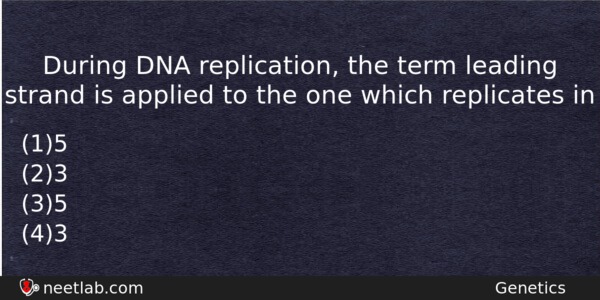| ⇦ | 
| ⇨ |
During DNA replication, the term leading strand is applied to the one which replicates in
Options
(a) 5′ → 3′ direction discontinuously
(b) 3′ → 5′ direction continuously
(c) 5′ → 3′ direction continuously
(d) 3′ → 5′ direction discontinuously
Correct Answer:
5′ → 3′ direction continuously
Explanation:
When the double helix of DNA unwinds, DNA replication on one of the two strands (3′ to 5′ strand) can easily proceed continously in 5′ to 3′ direction. This is the leading strand. On the other strand (5′-3′) if the synthesis has to take place in 5′ to 3′ direction, it has to be synthesized in a direction opposite to that on the leading strands. This strand is the lagging strand and on this strand synthesis takes place in segments discontinously and these segments are called Okazagi fragments which then fuse to create an intact lagging strand. This behaviour where the leading strand is synthesized continously and the lagging strand is synthesized discontinously is called semi-discontinous replication.
Related Questions: - A species facing extremely high risk of extinction in the immediate future is called:
- Megasporangium is equivalent to
- Due to plasmolysis, the plant cell
- All plastids have similar structure because they can
- Desert grasses often roll their leaves due to presence of
Topics: Genetics
(204)
Subject: Biology
(4253)
Important MCQs Based on Medical Entrance Examinations To Improve Your NEET Score
- A species facing extremely high risk of extinction in the immediate future is called:
- Megasporangium is equivalent to
- Due to plasmolysis, the plant cell
- All plastids have similar structure because they can
- Desert grasses often roll their leaves due to presence of
Topics: Genetics (204)
Subject: Biology (4253)
Important MCQs Based on Medical Entrance Examinations To Improve Your NEET Score
18000+ students are using NEETLab to improve their score. What about you?
Solve Previous Year MCQs, Mock Tests, Topicwise Practice Tests, Identify Weak Topics, Formula Flash cards and much more is available in NEETLab Android App to improve your NEET score.
Share this page with your friends

Leave a Reply